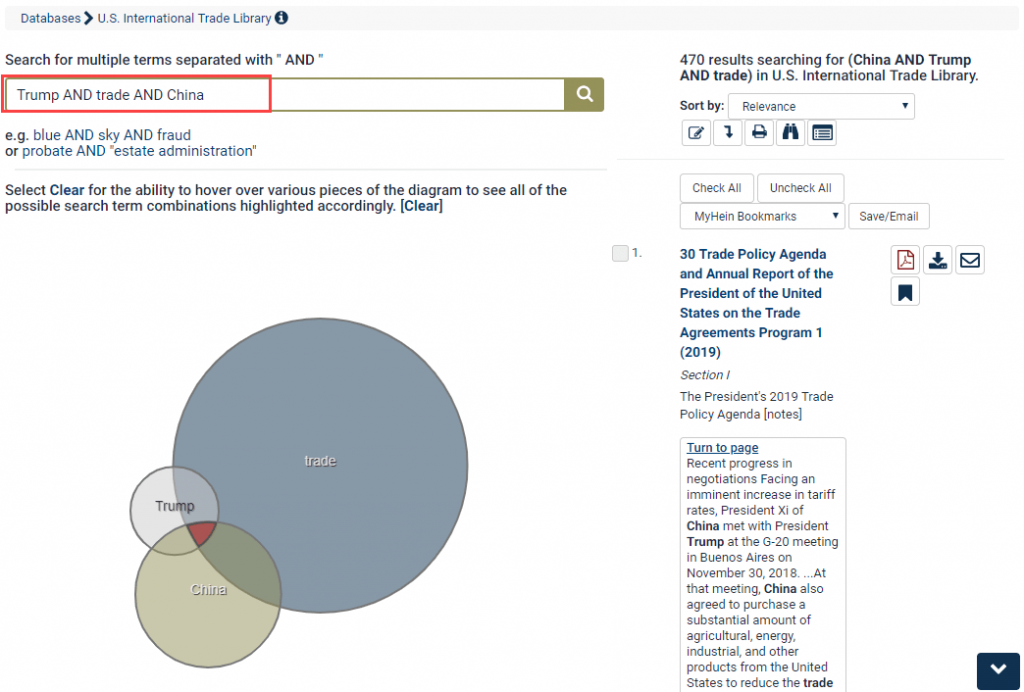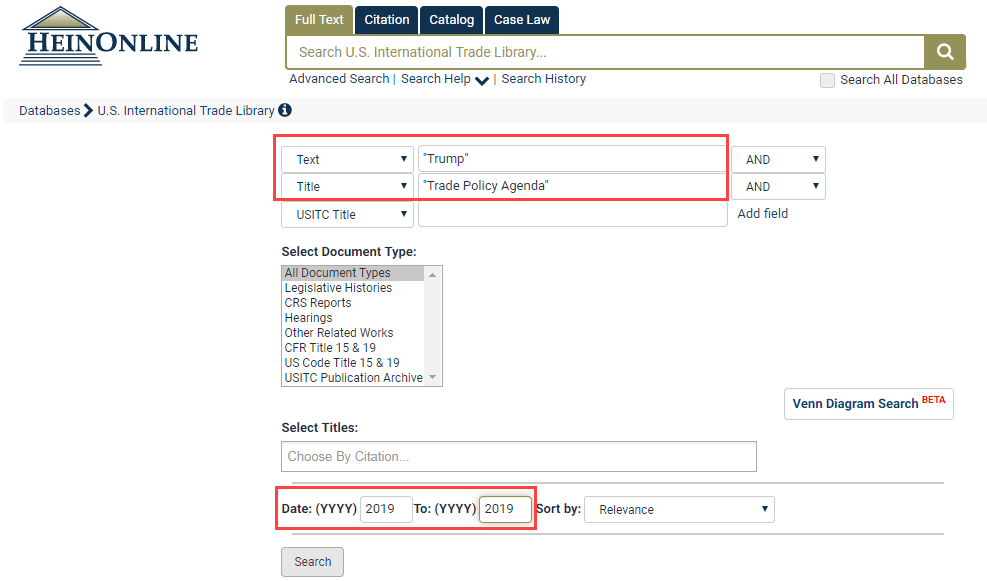Over the past year, the Trump Administration has imposed steep tariffs on billions of dollars’ worth of products from the European Union, Canada, Mexico and, in particular, China. The affected countries have responded with their own tariffs on thousands of U.S. goods. With some of the world’s wealthiest economies at each other’s throats, the foundation of global trade is being rocked to its core.
As historic developments in international trade unfold, stay informed with HeinOnline’s U.S. International Trade Library.
U.S. International Trade Library
Featuring the exchange of goods and services between the United States and other nations, as well as the history of Section 337 of the Tariff Act of 1930, this collection brings together more than 2.3 million pages of content. Included in this database:
- Archived publications from the United States International Trade Commission, dating back to 1961.
- Legislative histories of more than 50 acts relating to international trade.
- Title 15: Commerce and Foreign Trade and Title 19: Customs Duties of both the Code of Federal Regulations and U.S. Code, available from inception to date.
- Scholarly articles and nearly 1,100 other works related to international trade.
Overview of the U.S.-China Trade Conflict
Since 2016—even before he took office—President Trump voiced his criticisms of Chinese trade policies, and promised as part of his campaign to end international trade deals. In the past year, President Trump has followed through on promises to impose sweeping tariffs on Chinese goods due to the country’s alleged unfair trade practices. Intended to reduce the United States’ trade deficit with China, U.S. tariffs have been applied to $250 billion worth of Chinese goods, and President Trump has stated his plans to impose $325 billion more. In response, China has placed tariffs on $110 billion worth of U.S. goods and has threatened to take other qualitative measures in retaliation.
With both President Trump and Chinese President Xi Jinping staunchly opposed to backing down, the conflict between the two countries is developing into a full-blown trade war, one which China’s Ministry of Commerce has called the “the largest trade war in economic history to date.”
A trade war is an economic conflict which results from the creation of increased trade barriers by two or more countries on each other’s goods. Trade barriers are government-sanctioned restrictions on global trade which commonly take the form of tariffs—taxes on a country’s imports and exports—but can also be imposed by other mechanisms. Non-tariff trade barriers can impede trade between countries either overtly or covertly in many forms, including import quotas, embargoes, anti-dumping laws, subsidies, industry bailouts, licensing requirements, and more. Free trade is characterized by the removal of unnecessary trade barriers.
Learn more about President Trump’s activities in international trade with HeinOnline’s International Trade Library. From the home page, run a basic full-text search for “Trump” AND “trade” to view more than 530 related results. Relevant results include:
- Trump Administration Tariff Actions: Frequently Asked Questions
- U.S.-China Trade Issues
- Enforcing U.S. Trade Laws: Section 301 and China
- International Trade and Finance: Overview and Issues for the 116th Congress
Users can further understand the relationship between Trump, trade, and China by performing a Venn Diagram Search within the U.S. International Trade Library. From the home page of the database, click on the Advanced Search hyperlink directly below the main search bar. Select the button marked Venn Diagram Search and enter “Trump AND trade AND China” into the search bar. The resulting diagram illustrates the relationship between all three search terms at once, as well as the various combinations of the three.

Refer to the timeline of events below to further understand the context of the U.S.-China trade conflict with HeinOnline.
Timeline of Events
August 2017
- In his mid-August memorandum, Trump called for U.S. Trade Representative (USTR) Robert E. Lighthizer to investigate any Chinese trade practices which may be harmful to United States intellectual property, innovation, or technology.
- The U.S. Trade Representative initiated the investigation of China under Section 301 of the Trade Act of 1974 in response to Trump’s memorandum. Section 301 of this act authorizes the President to take any appropriate action to end any foreign practice which is in violation of an international trade agreement or which is unjustified, unreasonable, discriminatory, or detrimental to U.S. commerce. View the legislative history of the Trade Act of 1974 in HeinOnline’s U.S. International Trade Library.
March 2018
- The results of the USTR’s investigation of China were released, finding that China had indeed performed unfair trade practices under Section 301, particularly related to technology transfer, intellectual property, and innovation.
April 2018
- The United States threatened to impose 25% tariffs on a $50 billion list of Chinese goods, including machinery, electrical equipment, and mechanical appliances. View the U.S. Trade Representative’s notice of determination and request for public comments on the action in the Federal Register.
- In retaliation, China published a list of 106 U.S. products on which it threatened to impose its own 25% tariffs, targeting U.S. transportation and agricultural products.
- The Trump Administration then further escalated the trade conflict by requesting that tariffs be placed on $100 billion of additional U.S. imports from China.
June 2018
- A second, revised list of products was released by the US Trade Representative, on which 25% tariffs would be imposed in two phases. View the USTR’s notice of action and request for public comments on the new list.
- On the same day, China issued its own updated list of retaliatory 25% tariffs which targeted $50 billion worth of U.S. exports to China, adding medical equipment and mineral fuels but removing aircraft goods.
- Again, President Trump requested more tariffs, this time at 10% for an additional $200 billion worth of Chinese imports. In the same statement, Trump threatened to raise additional tariffs on another $200 billion of goods should China respond with further retaliatory tariff increases.
July 2018
- The United States and China initiated the first phase of their $50 billion lists, each launching tariffs on $34 billion worth of goods.
- President Trump’s June request for more tariffs was approved four days later with the USTR’s release of a list of the $200 billion Chinese imports to be taxed. Combined with the original list, the proposed tariffs at this point covered $250 billion of Chinese goods. View the USTR’s proposed modification of action.
August 2018
- Trump requested that the USTR consider increasing the 10% tariff on the additional $200 billion list to 25%.
- China threatened to add tariffs from 5-25% on $60 billion of U.S. imports following Trump’s newest threat.
- The United States and China revised the second phases of their June $50 billion lists of imports (each worth $16 billion). The United States removed 5 products out of 284 on the initial list, and China removed crude oil tariffs.
- Later in the month, the U.S. and China went through with the second phase of tariffs on $16 billion of imports, completing the initial tariff announcements from April.
September 2018
- The Trump administration announced the final list of $200 billion Chinese imports on which a 10% tariff would be imposed, as well as an increase to 25% effective at the beginning of the new year. Trump further stated that if China takes retaliatory action, the U.S. will institute a third phase of tariffs on $267 billion of additional imports.
- In turn, China released its finalized list of $60 billion of U.S. imports to be taxed in the event that Trump proceeded with the latest tariff threat. Rather than the original 5-25%, tariffs on the finalized list ranged from 5-10%.
- Later in the month, both the U.S. tariffs and the Chinese retaliatory tariffs went into effect. View the notice of modification from the U.S. Trade Representative.
December 2018
- A meeting between Presidents Trump and Xi resulted in a deal which would pause the January 2019 tariff escalation while the two negotiated trade issues. However, the details of the deal were vague. No joint statement was offered from the two presidents, and conflicting statements were made by the White House and Chinese state. The U.S. statement announced that if an agreement has not been reached by March 1, 2019, the 25% tariff increase would go into effect.
February 2019
- Trump delayed the March 1 tariff increase in an announcement on Twitter, crediting significant progress made in trade negotiations with China.
May 2019
- Though expected to meet with China for further trade talks, President Trump suddenly announced that the 10% tariff on the $200 billion of imports would increase to 25% on May 10, 2019. Trump also stated that the U.S. would soon impose 25% tariffs on all remaining Chinese imports not yet affected by the previous tariffs. The remaining imports were said to be worth $325 billion, and included toys, clothing, electronics, and footwear. View the notice of modification from the U.S. Trade Representative.
- On May 10th, Trump followed through with increasing the 10% tariff to 25%. In retaliation, China announced its intention to increase the tariff rate on its previous list of $60 billion US imports.
June 2019
- China’s forewarned increase in tariff rate went into effect on $36 billion of the original $60 billion list.
- President Trump and President Xi are expected to meet again for trade negotiations in late June.
Only time will tell how the U.S.-China trade relationship will further develop. In the meantime, use HeinOnline’s International Trade Library to read President Trump’s 2019 Trade Policy Agenda.
From the database home page, perform an Advanced Search by selecting the blue hyperlink underneath the main search bar. Next to Text, type “Trump.” Next to Title, type “Trade Policy Agenda.” In the Date range, enter “2019” into both boxes. Select the Search button to view one result.

Keep up with current developments in international trade as HeinOnline continues to grow its International Trade Library. Request your free trial today.
Enjoy learning about the context of hot topics? Curious about the other special collections offered in HeinOnline? Click the Subscribe button at the top of this post to stay in the know.
Don’t forget to connect with us on our social media platforms: Facebook, Twitter, Instagram, and YouTube.



